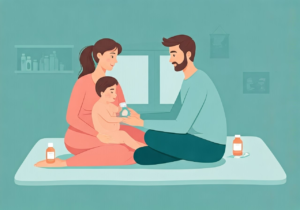If you and your partner are among the 12 percent of couples dealing with infertility, you know that coping with problems conceiving can be difficult. And while fertility treatments can go a long way toward getting pregnant, navigating all the options is likely to increase your stress level.
But having a quick overview of the options can help. That’s where this guide comes in. Use it to learn the basics of the most common fertility treatments. Once you have an idea of what might be right for you, you can discuss it with your doctor and do further research to get more details.
Advantages Of Fertility Treatments
Fertility Treatment may be more successful than IUI and other forms of assisted reproductive technology. Fertility treatment success rates have been increasing since its inception, thanks to advances in technology.
Although IUI and other forms of assisted reproductive technology may be successful for some patients, in general, they have not experienced the same level of improvement and do not currently have as high success rates.
It can help single women and same-sex couples. For single women or same-sex couples who wish to have a child, fertility treatment can provide a great opportunity to help them become parents if IUI has not been successful. Donor sperm IVF can help potential patients achieve this goal.
Fertility Treatment can help diagnose fertilization problems. In some cases of unexplained infertility, there could be a problem with fertilization. Cases like these may not be diagnosed until fertilization is attempted in the laboratory. Although this would be a disappointing result, it is helpful to be able to uncover such issues in order to find solutions for future ICSI treatment.
Unused embryos can be donated for research or for another couple. If you are lucky enough to have embryos to spare, these can be used to help other people and even save lives.

With the permission of the biological parents, unused embryos can be donated for research purposes or to another couple so that they can have a child. This is also an advantage of having fertility treatment.
Embryos can be used to detect inherited diseases. For people who are known carriers of genetic disorders such as cystic fibrosis, Huntington’s disease, and muscular dystrophy, IVF with preimplantation genetic diagnosis (PGD) is one of the most reliable ways to ensure that a child conceived does not suffer from the disorder.
Pre-implantation genetic screening (PGS) can improve the chances of a successful outcome by detecting embryos for chromosomal disorders such as Down syndrome. Both techniques are available in our clinics.
Unused embryos can be donated for research or for another couple. If you are lucky enough to have embryos to spare, these can be used to help other people and even save lives. With the permission of the biological parents, unused embryos can be donated for research purposes or to another couple so that they can have a child.
Embryos can be used to detect inherited diseases. For people who are known carriers of genetic disorders such as cystic fibrosis, Huntington’s disease, and muscular dystrophy, fertility treatment with preimplantation genetic diagnosis (PGD) is one of the most reliable ways to ensure that a child conceived does not suffer from the disorder.
Pre-implantation genetic screening (PGS) can improve the chances of a successful outcome by detecting embryos for chromosomal disorders such as Down syndrome. Both techniques are available in our clinics.

The fundamental advantage of fertility treatment is that it allows a couple to have their own biological child, rather than using a donated egg or sperm. Besides being useful in cases of infertility related to the fallopian tubes, fertility treatment is also indicated in cases of unexplained infertility or if there are minor problems with the man’s sperm.
The procedure allows couples the option of examining the embryos for hereditary diseases or chromosomal problems if they so desire. Fertility Treatment is appropriate for single women or same-sex couples.

Confirmation of fertilization is also an advantage of having fertility treatment. For some people, the cause of their subfertility is labelled “idiopathic” (a technical term for unknown). In cases like this, there may be a problem with the interaction of the egg and the sperm in the normal way, preventing the creation of an embryo.
If the sperm and the egg do not interact in an IVF cycle and embryos are not created, this is called “failed fertilization.” While this is devastating for the couple, it can also provide some answers as to why they have not been successful in achieving pregnancy naturally in the past.
Fertility Treatment procedures have been performed for more than 30 years, and the first human baby was born in 1978.
During this time, scientists, nurses, and fertility specialists have been constantly developing new drugs and medical procedures to increase the success rate of fertility treatment in India. Fertility treatment procedure, while minimizing the risks of complications associated with the procedure.
Despite this constant review and the advent of new technologies, there are still risks and disadvantages associated with this treatment option.
Home insemination and intrauterine insemination (IUI)
What it is: Home insemination involves placing sperm from your partner (or donor) into your reproductive tract during ovulation so that conception can take place. If you are ovulating normally, AI can be done without any additional fertility drugs. If you have problems with ovulation, AI with fertility drugs can increase your chances of getting pregnant.
Intrauterine insemination (IUI) is a similar process, but a little more complicated. Rather than simply placing the sperm into the reproductive tract, a thin catheter is used to place the sperm directly into the uterus, increasing the chances that the sperm will meet the egg.
These procedures may be suitable for couples who have a low sperm count or poor sperm motility, same-sex couples or couples using a surrogate, or single women who want to become mothers on their own.
AI or IUI is also a good first choice for those with unknown fertility problems. Up to 40 percent of women under 40 who undergo AI will get pregnant in six attempts. For IUI, the success rate ranges from 5 to 20 percent.

These procedures may be suitable for couples who have a low sperm count or poor sperm motility, same-sex couples or couples using a surrogate, or single women who want to become mothers on their own. AI or IUI is also a good first choice for those with unknown fertility problems.
There are no real risks for artificial insemination at home, but the procedure won’t work for everyone. AI and IUI are less likely to be effective in women over 40 years of age, as well as those with blocked fallopian tubes, a history of pelvic infections, or significant endometriosis. It probably won’t work for major male infertility problems either.
In vitro fertilization (IVF)
What it is: During IVF, your eggs are fertilized by sperm outside your body at a fertility lab or clinic. Then one or more of the fertilized eggs are transferred to your uterus in the hope that it will implant and result in a pregnancy.
Your doctor may recommend IVF if AI or IUI have not worked for you. IVF can also be a good option for those with severe fallopian tube blockages, ovulation disorders, decreased ovarian reserve, poor egg quality, endometriosis, or insurmountable sperm deficiencies.
Same-sex couples, couples using donor eggs, or any couple who may need to use preimplantation genetic diagnosis or screening (PGD / PGS) to screen embryos for genetic disorders might also consider IVF.
IVF success rates vary based on a woman’s age: up to 50 percent for women under 35, 38 percent for women 35-37, 24 percent for women from 38 to 40, and 12 percent for women 41 to 42 years and under 4 percent for women over 42 years.
You will need to take hormone injections before the eggs can be collected for fertilization, which can cause unpleasant side effects. The procedure itself is invasive, and implantation of more than one fertilized egg also increases the chances of having twins or multiples, increasing the chances of possible complications. Also, it can be expensive if not covered by insurance.
Natural cycle IVF
What it is: Natural cycle IVF is a term for in vitro fertilization that ignores the hormone injection phase. Instead, your doctor will monitor your natural cycle and retrieve a single egg when you are ready to ovulate. Your egg will then be fertilized in a fertility lab or clinic, just like with traditional IVF, and transferred to your uterus.
Who is a good candidate? If AI or IUI haven’t worked, but you’re very determined to avoid hormones, natural cycle IVF may be worth considering. The same is true for women who have only been able to retrieve one egg from traditional IVF cycles.
An advantage over traditional IVF is that since the procedure retrieves only one egg, there is no risk of multiples and associated complications. The success rate for this Fertility treatment is also about 20-25 percent. You are less likely to get pregnant with natural cycle IVF compared to traditional IVF.
Donor eggs
A donor egg from a fertile woman is fertilized with sperm and implanted in the uterus, similar to IVF. The donor can be someone you know or someone with whom you are assigned anonymously through an agency. Using a donor egg means that it will not be related to your baby biologically, but is still listed as the registered biological mother.
If traditional IVF cycles haven’t worked, donor eggs may be the next step. The procedure may also be suitable for women with a low egg count or poor egg quality, which is more likely after age 40. Donor eggs are also an option if you have a genetic disorder or serious condition that you want to avoid passing on to your child.
Success rates of at-home insemination are also up to 55 percent when using fresh donor eggs and up to 40 percent when using frozen donor eggs. Using donor eggs can be a long and expensive process. And as with traditional IVF, there is a risk of multiples and related complications.
Surrogacy
A surrogate mother bears a child from another woman or same-sex partner In virtually all cases, the parents undergo IVF and the embryo is implanted in the surrogate’s uterus. Both parents have a genetic link to the baby, but the surrogate mother does not.
Surrogacy may be a good option for couples who want a biological child but cannot have a pregnancy. Gay couples or women who cannot maintain a pregnancy, do not have a uterus, or have a medical condition that would make pregnancy dangerous or impossible might also consider surrogacy. Success rates are about 50 percent when the egg comes from a woman under 35, but that can drop below 10 percent if the donor is over 42.
Surrogacy is an intensely emotional process that can take a year and a half or more. There are also important legal issues to address: It is in the best interest of the surrogate parents to have a contract that spells out details such as parental rights and custody, as well as medical treatment during pregnancy and labour and childbirth. And it is important to note that surrogacy is currently illegal in some states, and some states do not recognize surrogacy contract agreements. Be sure to check the laws in your state.
Egg freezing
10 to 20 of a woman’s eggs are retrieved in a procedure similar to IVF, then frozen and stored. When you are ready to have a baby, one or more of the eggs are thawed, fertilized, and implanted in your uterus. Egg freezing is worth considering if you know you want to have children at some point, but not for a while.
It may also be a good option for women undergoing cancer treatment or those with a family history of early menopause, endometriosis, or ovarian cysts. Women in their 20s and 30s have the best chance of retrieving, freezing, and storing healthy eggs.
Successful pregnancy rates with frozen eggs start at 36 percent for women under 35, and then drop to 30 percent for women 38 to 40, and 26 percent for women 41 to 42 years. Egg freezing is generally not recommended for women ages 40 to 40.
Since 90 percent of women who have frozen their eggs have not yet used them, experts don’t know much about how long frozen eggs will last in storage. Also, just like with traditional IVF, you must take fertility drugs, which can have unpleasant side effects, and the procedure itself is invasive.
Fertility drugs
Fertility drugs are taken at the beginning of IVF, but you can also take them alone for ovulation problems. Oral medications like Clomid and Femara are used to stimulate the ovaries and correct irregular ovulation.
Both drugs work by suppressing the production of estrogens, which stimulates the production of hormones that stimulate ovulation. If oral medications don’t work, there are injections of hormones called gonadotropins that directly stimulate ovulation.
If intrauterine insemination (IUI) hasn’t worked for you, artificial insemination kit may be more successful with fertility drugs. You can also take fertility drugs while trying to conceive on your own without AI or IVF. Successful pregnancy rates with fertility drugs depend on the drug. For hormone injections it is 32 percent, for Clomid, it is 23 percent and for Femara, it is 18 percent. You may experience side effects such as bloating, nausea, headaches, mood swings, or breast tenderness.
Hormone injections also carry a slight risk of ovarian hyperstimulation syndrome, in which the ovaries become swollen and painful. Fertility drugs also increase the chances of having multiple babies, as they can cause two or more eggs to be released at the same time.

Conclusion
There can be many reasons for opting for home insemination kit. These include difficulty getting pregnant, the desire to be a single mother, etc. Most people undergo home insemination procedures under the guidance of their Gynecologist, who generally has good experience with the subject.
However, if you are one of those who do not like the idea of doing this at a fertility clinic, there is the option of doing it at home as well.
The effectiveness rate is slightly lower than what would happen with natural intercourse. For example, anecdotal evidence shows that the chances of getting pregnant with home insemination at home are around ten to fifteen percent per ovulation, while with natural intercourse the chances are much higher, between twenty and thirty percent.
The sperm can be from your partner or from an unknown donor. Sperm banks are the best option for the latter since they keep specific and clear records about the donor’s genetics, the quality of the sperm, etc. Be sure to use a legal agreement when taking sperm from someone you know, in case only you want rights to the baby.
However, home insemination is one the best and effective way for all fertility treatment.



